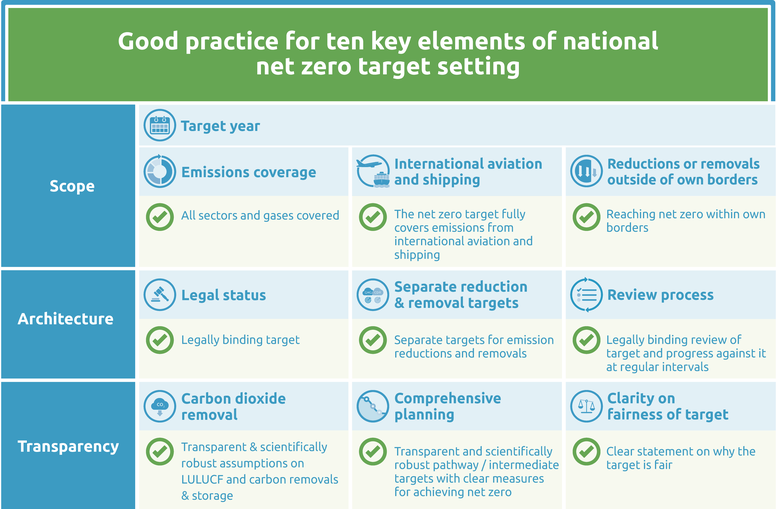Net zero targets
Summary
CAT evaluates Singapore’s net zero target as: Poor
Singapore has committed to net zero GHG emissions by 2050 as part of its Long-Term Low Emissions Development Strategy (LT-LEDS) (National Climate Change Secretariat, 2020, 2022). In its initial Strategy, submitted in 2020, it had set the target year as ‘as soon as viable in the second half of the century’ (National Climate Change Secretariat, 2020). It amended the target year in its 2022 addendum to the strategy, bringing it forward to 2050.
Singapore has outlined detailed sector-specific policies and measures targeting power, industry, transport, building and waste, but its Strategy misses to provide details on the mitigation potential of those measures, outline an emissions pathway to net zero, nor provide any detail on the extent to which carbon capture, utilisation and storage (CCUS) will be used to achieve the target. The Strategy outlines its support for measures taken to address emissions from international aviation and shipping, though these sectors are not specifically included in its target. No review processes have been established for Singapore’s long-term target.
CAT analysis of net zero target
Ten key elements
Scope
- Target year – Singapore aims to reach net zero by 2050. This is an improvement on its initial Long Term Low Emissions Development Strategy (LT-LEDS) of 2020 in which Singapore committed to achieving net zero emissions ‘as soon as viable in the second half of the century’ (National Climate Change Secretariat, 2020, 2022).
- Emissions coverage – The target covers all GHG emissions (i.e., the seven Kyoto gases: CO2, CH4, N2O, HFCs, PFCs, SF6, NF3) and all sectors of the economy (excluding international bunkers) (National Climate Change Secretariat, 2022; Singapore Government, 2022). The amended LT-LEDS does not specify gas coverage, however as the NDC covers all gases and the net zero target is also referred to in its updated NDC submission, we assume the net zero target also covers all gases as well (National Climate Change Secretariat, 2022; Singapore Government, 2022).
- International aviation and shipping – Singapore provides no information on its intention to cover international aviation and shipping emissions, which exceed Singapore’s national, domestic emissions by more than three times. In its LT-LEDS of 2020, Singapore expressed its support for the efforts of the International Civil Aviation Organization (ICAO) and the International Maritime Organization (IMO) to reduce emissions from the international aviation and maritime transport sectors respectively, however neither the 2020 LT-LEDS nor the 2022 LT-LEDS addendum specify whether these sectors are covered by its net zero target (National Climate Change Secretariat, 2020, 2022).
- Reductions or removals outside of own borders – Singapore reserves the right to the use of international offset credits to meet its net zero target (National Climate Change Secretariat, 2022). It does not provide details on the extent to which it plans to rely on these mechanisms, but notes that it has already signed MoUs with several countries to collaborate on carbon credits (Carbon Herald, 2022; Morocco World News, 2022).
Target architecture
- Legal status – The Singaporean government included its net zero target in its long-term strategy (LTS) submitted to the UNFCCC in 2020 and subsequent addendum of 2022 (National Climate Change Secretariat, 2020, 2022). The net zero target has not yet been enshrined in law as of April 2024.
- Separate reduction & removal targets – Singapore does not provide separate emission reduction and removal targets. In its LT-LEDS, Singapore committed to the long-term sustainability of its forests and intends that its green spaces would serve as sink, though no specific target is mentioned (National Climate Change Secretariat, 2020).
- Review process – Singapore provides no information on its intention to establish a review cycle for its net zero and intermediate targets. Its LT-LEDS stipulates reviews of certain sectoral measures, but not the net zero strategy itself.
Transparency
- Carbon dioxide removal – Singapore does not provide transparent assumptions on carbon dioxide removals. Singapore intends to use its green spaces as a LULUCF sink but provides no information on the magnitude of expected removals (National Climate Change Secretariat, 2020).
- Comprehensive planning – In its LT-LEDS of 2020 and addendum of 2022, Singapore provides detailed sector-specific action areas but does not provide details on the mitigation potential of those measures, nor any emissions pathways to net zero. The LT-LEDS mentions the potential of CCUS to reduce emissions from Singapore’s industries and power sector, critically depending on the cost of capture and suitable geological formation for permanent storage. It remains uncertain as to what extent the government intends to rely on these measures to achieve net zero.
- Clarity on fairness of target – Singapore makes no reference to fairness nor equity in the context of its net zero target. Its amended LT-LEDS notes the relative size of its contribution to global emissions and that it has taken early action on mitigating climate change. However, this “early action” is described as switching from one fossil fuel to another for electricity generation, i.e. fuel oil to fossil gas, which both need to be phased out completely.
Good practice
The Climate Action Tracker has defined the following good practice for all ten key elements of net zero targets. Countries can refer to this good practice to design or enhance their net zero targets.
Further analysis
Latest publications
Stay informed
Subscribe to our newsletter







